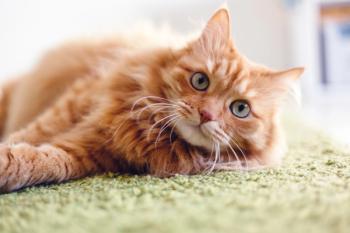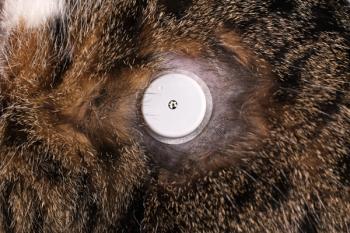
What's new with hyperthyroidism in cats (Proceedings)
Feline hyperthyroidism was first described in 1979 by Peterson and 1980 by Holzworth. It is now estimated that the incidence is as high as 2% of the feline population seen in tertiary veterinary care facilities.
What we know
Feline hyperthyroidism was first described in 1979 by Peterson and 1980 by Holzworth. It is now estimated that the incidence is as high as 2% of the feline population seen in tertiary veterinary care facilities. Hyperthyroidism is the most common endocrine disorder affecting older cats and is caused by adenomatous hyperplasia of the thyroid gland. There is no breed or sex predilection.
Hyperthyroidism is characterized by hypermetabolism including polyuria, polydipsia, and polyphagia with concurrent weight loss. The sympathetic nervous system is activated as well causing hyperactivity, hypertension, tachycardia, tachyarrhythmia, and behavioral changes. Long-standing hyperthyroidism results in hypertrophic cardiomyopathy, high-output heart failure and cachexia.
Common laboratory findings include erythrocytosis, elevated mean corpuscular volume, alanine aminotransferase, and alkaline phosphatase. Azotemia is not uncommon, which is important considering the glomerular filtration rate decreases substantially after treatment of hyperthyroidism and can worsen azotemia and result in renal failure. It is important to closely monitor treated animals for (worsening) renal function.
Hyperthyroidism is diagnosed by measurement of total tetraiodothyronine (TT4) and is diagnostic in about 90% of cases. A normal TT4 is present in about 10% of the cases due to concurrent non-thyroidal illness, a fluctuating TT4 level, mild hyperthyroid cases or concurrent medications that lower serum TT4 levels. Free T4 (FT4) by equilibrium dialysis measurements have been shown to be more diagnostic of early or "occult" hyperthyroidism. Elevated FT4 concentrations should be interpreted concurrently with the TT4 because non-thyroidal illness (chronic renal failure) can result in spurious elevations of FT4 as well. Elevated T3 levels only occur in approximately 70% of the cases.
Feline benign functional thyroid adenoma resembles toxic nodular goiter (TNG) of humans. The pathogenesis of TNG is an abnormality in the signal transduction of the thyroid cell. The TSH receptors of the thyroid cells activate receptor-coupled guanosine triphosphate binding proteins (G proteins). Recent research showed some hyperthyroid cats express this TSH receptor activation mutation and have significant decreases in G inhibitory protein.
Does nutrition impact hyperthyroidism? Canned cat food has been implicated as a cause of feline hyperthyroidism in many epidemiological studies. The suspected goitrogen is bisphenol-A-diglycidyl ester (BADGE). BADGE is used in making the liner of the easy open 'pop-top' cans and suspected to leach into the foods consumed by cats. While this appears safe for human consumption, cats are proposed to be more susceptible to the toxic effects of this compound due to a greatly reduced ability to detoxify it via hepatic glucuronidation. Although feline studies are not readily available Bisphenol A reduces triiodothyronine binding and causes increased TSH secretion resulting in hyperthyroidism and goiter in rats and some humans. Although epidemiological studies showed association, over 90% of cats in the US consume commercial pet foods and relatively few develop hyperthyroidism.
Does environment impact development of hyperthyroidism? In 2007, Janice Dye, a researcher with the US EPA, implicated polybrominated diphenyl ethers (PBDEs) as goitrogens associated with feline hyperthyroidism. PBDE wide spread usage started in the 1980's as a flame retardant. It is used in upholstery, drapes, plastic covering of televisions and computers. This abstract reported serum PBDE levels 10- to 400-fold higher than humans. It is proposed that these levels are dramatically increased due to increased exposure to furniture and carpets and meticulous grooming behavior. Another study cited cat litter usage was associated with increased risk of hyperthyroidism. No recognizable difference between litter types was found suggesting that use of cat litter is simply a marker of indoor living. Indoor cats are likely to live longer and possibly develop more diseases.
What's new?
In the last few years' new studies have provided new information affecting the diagnosis and management of the disease. The purpose of this lecture is to discuss the clinical implications of the recent studies concerning hyperthyroidism. The following includes direct citations from the referenced articles.
• Riensche MR, Graves TK et al. An investigation of predictors of renal insufficiency following treatment of hyperthyroidism in cats. J Feline Med Surg 2008; 10:160-6.
- A retrospective study reviewing signalment, clinical signs, hematologic, serum biochemical, and urinalysis results before and after treatment for hyperthyroidism. Cats that developed post-treatment renal insufficiency and those that remained normal were compared. With respect to parameters measured, there were no significant differences. This study suggests the results of pre-treatment clinical data cannot reliably be used to predict renal function after hyperthyroidism treatment. It was suggested to perform a methimazole trial prior to definitive therapy for hyperthyroidism.
• Van Hoek I, Lefebvre HP, et al. Short- and long-term follow-up of glomerular and tubular renal markers of kidney function in hyperthyroid cats after treatment with radioiodine. Dom An Endo 2009; 36(1) 45-56.
- This was the first prospective study evaluating the short- and long-term (24 weeks) follow-up of routinely used serum and urinary renal variables (BUN, serum creatinine, TT4, UPC, and USG), blood pressure, body weight as well as two other variables, GFR and a promising new urinary marker, urinary retinol binding protein (uRBP). The latter two were used to indicate glomerular and tubular function before and after 131 I treatment. All were evaluated before and 1, 4, 12 and 24 weeks post treatment. GFR at four weeks post treatment and maximum decrease in GFR could be partially predicted by a formula using pre-treatment GFR, serum TT4, serum creatinine, BUN, and/or USG. Significant changes in kidney function occurred within four weeks post-treatment and none thereafter. Measurement of pre-treatment GFR, USG, and serum TT4 can have possible predictive value regarding development of post-treatment renal azotemia.
• Harvey AM, Hibbert A, et al. Scintigraphic findings in 120 hyperthyroid cats. J Feline med Surg 2009; 11(2) 96-106.
- This study characterized scintigraphic findings in newly diagnosed hyperthyroid cats and those cats that had previously undergone thyroidectomy. A specific purpose was to identify the proportion of cats with ectopic hyperfunctional thyroid tissue. In this study, intrathoracic hyperfunctional thyroid tissue and multiple areas of increased radionuclide uptake (IRU) were a common finding. This study also demonstrated that scintigraphy could not reliably discern between thyroid carcinoma and adenoma.
• Boretti FS, Sieber-Ruckstuhl NS, et al. Thyroid enlargement and its relationship to clinicopathological parameters and T4 status in suspected hyperthyroid cats. J Feline Med Surg 2009; 11: 286-292.
- The ventral neck of 161 cats with clinical signs consistent with hyperthyroidism was examined by two independent, experienced clinicians using a semi-quantitative palpation system. Thyroid gland size of each side was scored from 0 (non-palpable) to a maximum of 6 (>25 mm). The palpation score was significantly correlated with the T4 concentration. Seventeen hyperthyroid cats had significantly higher palpation scores that the 110 euthyroid cats. Although no reliable conclusion on the functional status of the thyroid can be drawn based on its size, the likelihood of hyperthyroidism increases with increasing size of the gland.
• Rutland BE, Nachreiner RF, Kruger JM. Optimal testing for thyroid hormone concentration after treatment with methimazole in health and hyperthyroid cats. J Vet Int Med 2009; 23(5): 1025-30.
- Optimal time for blood sampling to monitor therapeutic efficacy of methimazole treatment for hyperthyroidism has not been determined. Thyroid hormones and thyroid stimulating hormones (TSH) were serially and randomly monitored after methimazole in four healthy cats. These were compared to 889 retrospectively acquired feline thyroid hormone profiles The relationship between dosage (mg/kg), dosing interval (q 24h versus q 12h) and time after methimazole administration to all thyroid hormone concentrations. All serum concentrations of thyroid hormones were significantly suppressed and TSH was significantly increased for 24 hours after administration of oral methimazole in healthy cats. In hyperthyroid cats there were no significant relationships between thyroid hormone concentrations and time post pill or dosing interval. Timing of blood sample after oral methimazole administration does not appear to be a significant factor where assessing response to methimazole treatment.
• Wakeling J, Moore K, et al. Diagnosis of hyperthyroidism in cats with mild chronic kidney disease. J Small Anim Pract 2008; 49(6): 287-294.
- In cats with concurrent hyperthyroidism and non-thyroidal illness, such as chronic renal disease, total thyroxine concentrations are often within the laboratory reference range. In this study, 56 cats were grouped into three categories a) 16 cats with hyperthyroidism and concurrent chronic renal failure (CRF). TT4 levels were within reference range but later confirmed to be hyperthyroid. b) Chronic renal failure only (#20), c) Normal, healthy cats older than 8 years (#20). TT4, FT4 and thyroid stimulating hormone (TSH) were measured. In four of 20 euthyroid chronic renal failure cats FT4 concentrations were borderline or high. In the hyperthyroidism with CRF group, FT4 was high in 15 of 16 cats, while the TSH hormone was low in all cats. These results support the combined measurement of FT4 with TT4 or TSH may be of merit in the diagnosis of hyperthyroidism in cats with CRF.
• Berent AC, Drobatz KJ, et al. Liver function in cats with hyperthyroidism before and after 131 I therapy. J Vet Intern Med, 2007; 21(6): 1217-23.
- At the time of diagnosis, many cats with hyperthyroidism have elevations in liver enzymes. The clinical significance of these elevations is unknown. In this study, before and after 131I treatment, ALP, ALT, BUN, blood glucose, cholesterol, ammonia, albumin, serum bile acids and ultrasonographic appearance one liver enzyme, yet functional testing was normal. All cats received successful 131I treatment and all liver enzyme elevations returned to normal. This study supports the conclusion that investigation for liver disease is unnecessary in most cats with hyperthyroidism.
• Milner RJ, Channell CD, et al. Survival times for cats with hyperthyroidism treated with 131 I, methimazole or both: 167 cases (1996 - 2003). J Amer Vet Med Assoc, 2006; 228(4): 559-563.
- This study compared survival times for cats treated for hyperthyroidism. They were treated with 131I, methimazole or both and identified factors associated with survival times. Medical records of 167 cats were reviewed. Thirty-three percent of cats (55) were treated with 131I alone, 39% (65) were treated with methimazole followed by 131I, and 28% (47) were treated with methimazole alone. Fourteen percent (24/166) had preexisting renal disease and 69% (115/166) had preexisting liver disease. When cats with preexisting renal disease were excluded, median survival time for cats treated with methimazole alone (2.0 years) was significantly shorter than median survival time for cats treated with 131I alone (4.0 years) or methimazole followed by 131I (5.3 years). This suggests that age, preexisting renal disease, and treatment type were associated with survival time in cats undergoing medical treatment of hyperthyroidism.
• Lécuyer, M, Prini S, et al. Clinical efficacy and safety of transdermal methimazole in the treatment of feline hyperthyroidism. Can Vet J, 2006; 47(2): 131-135.
- Thirteen cats, newly diagnosed with hyperthyroidism, were treated with a transdermal formulation of methimazole at a dose of 5 mg (0.1 mL, concentration 50 mg/mL) applied to the internal ear pinna every 12 hours for 28 days. On days zero, 14 and 28 a physical examination was performed and baseline hematologic, biochemical and TT4 were obtained. Ten cats completed the study with clinical improvement as well as significant decrease in TT4. Only one cat showed an adverse cutaneous reaction along with marked thrombocytopenia. This study suggests that transdermal methimazole is an effective and safe alternative to conventional oral formulations.
• Frenais R, Burgaud S, et al. Treatment of feline hyperthyroidism with carbimazole. J Small Anim Pract, 2009: 50(10); 510-515.
- Traditional, medical treatment of feline hyperthyroidism had involved twice-daily use of the azole drugs, methimazole or its pro-drug, carbimazole. Many cats require twice daily treatment with these drugs. Intervet recently released a controlled release formulation of carbimazole. This study evaluated the efficacy and safety of this new drug. Treatment started at 15 mg/cat once daily and was adjusted as necessary for 53 weeks. The median dose over this period was 10-15 mg/cat once daily. Clinical signs improved in almost all cats within three weeks. Increased BUN was seen in 25%, Eosinophilia was noted in 20% and lymphopenia noted in 16% of the cats. This study concluded that once daily administration of controlled-release carbimazole is effective with acceptable tolerance during short and long-term treatment of hyperthyroidism.
• Henik RA, Stepien RL, et al, Efficacy of atenolol as a single antihypertensive agent in hyperthyroid cats. J Feline Med Surg 2008; 10(6): 577-582.
- Hypertension is a common complication of hyperthyroidism and chronic renal disease in cats. The current drug of choice for treatment of hypertension appears to be amlodipine due to its efficacy and low incidence of adverse e effects. However in cats with hypertension due to hyperthyroidism, beta-blocking drugs, such as atenolol, have been suggested to slow the heart rate and block effects of thyroid hormone on the cardiovascular system. Previously show to be ineffective to treat hypertension associated with chronic renal disease, it has not been studies for treatment of cats with hyperthyroidism. In this retrospective study, 20 hyperthyroid cats with systolic blood pressures over 160 mmHG were treated with atenolol (1-2 mgs/kg, PO, q12H). All cats were treated for a minimum of five days before reassessment and treatment with 131 I. While both heart rate and systolic blood pressure decreased in cats, successful clinical control of blood pressure was only achieved in 30% of cases. This concludes that although atenolol successfully controls heart rate in hyperthyroid cats, another drug is needed to successfully treat hypertension.
References available on request
Newsletter
From exam room tips to practice management insights, get trusted veterinary news delivered straight to your inbox—subscribe to dvm360.




